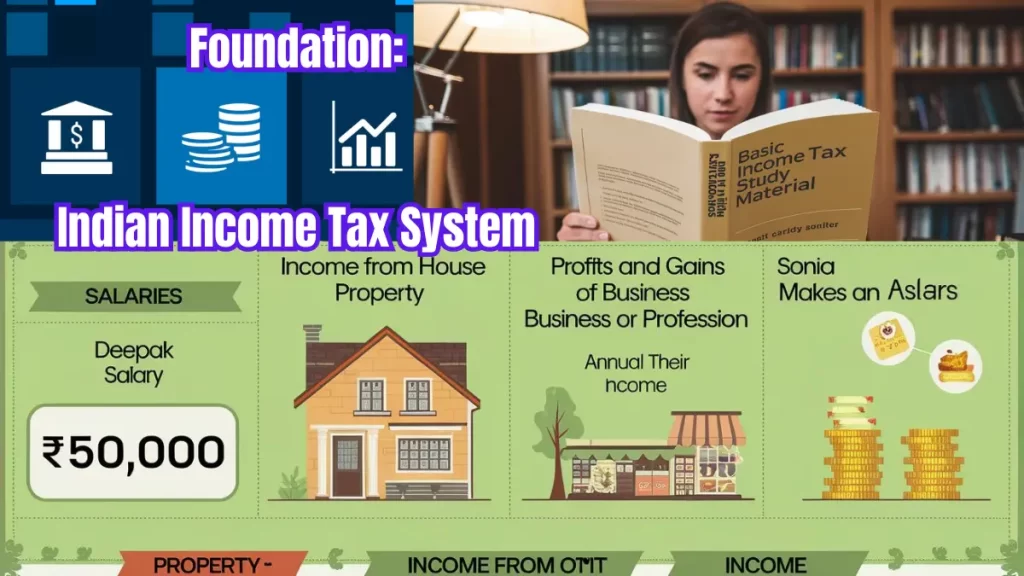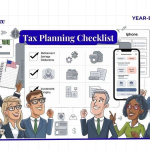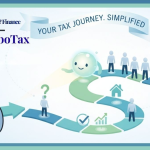Basic Income Tax Study Material
Chapter 1: Introduction
Welcome to the study of Income Tax! This chapter introduces you to the fundamental concepts of income tax in India. By the end of this chapter, you will learn about:
Know About the Course: Overview of Course Guide on Taxes Financial Year 2024-2025
This chapter lays the foundation for understanding the Indian income tax system. It will equip you with the essential vocabulary and concepts to delve deeper into more complex tax topics in later chapters.
Let’s begin our journey into the world of income tax!
[Detailed content of Chapter 1 follows…]

1. Definition and Types of Taxes
| Term | Definition | Examples |
| Taxation | As per Article 366(28) of the Constitution of India: “Taxation includes the imposition of any tax or impost, whether general or local or special, and tax shall be construed accordingly.” | Income Tax, GST, Property Taxes |
| Direct Taxes | Article 366(28) of the Constitution of India states, “Taxation includes the imposition of any tax or impost, whether general or local or special, and tax shall be construed accordingly.” | Income Tax, Corporate Taxes |
| Indirect Taxes | It is levied directly on the income or wealth of a person. The burden cannot be shifted. | Goods and Services Tax (GST), Custom Duty, Excise Duty |
Characteristics of Direct Taxes:
- Progressive nature – higher income leads to higher tax rate
- Difficult to bypass
- Promotes social equity
- Can be used as a fiscal policy tool
Characteristics of Indirect Taxes:
- Regressive in nature – same rate for all, regardless of income
- Easier to collect
- Wider tax base
- Can influence consumption patterns
2. Purpose and Importance of Taxes
| Purpose | Description |
| Revenue Generation | Primary source of government income for public expenditure |
| Economic Stability | Used as a tool for controlling inflation and deflation |
| Income Redistribution | Progressive taxation helps reduce income inequality |
| Resource Allocation | Taxes can influence the allocation of resources in the economy |
Key Areas Funded by Tax Revenue:
- Defence
- Education
- Healthcare
- Infrastructure Development
- Social Welfare Programs
- Public Administration
Also Read: Update Your Basic Income Tax Knowledge: Ultimate Guide 2024
3. Fundamentals of Income Tax Law in India
| Component | Description | Importance |
| Income-tax Act, 1961 | The annual act that may amend tax laws | Provides the legal framework for taxation |
| Finance Act | Annual act that may amend tax laws | Updates tax rates and introduces new provisions |
| Income-tax Rules | Procedural rules for implementing the Act | Provides detailed guidelines for compliance |
| Circulars and Notifications | Issued by CBDT to clarify provisions | Helps in interpreting complex tax issues |
| Legal Decisions | Judgments by various courts | Sets precedents for tax dispute resolution |
4. Detailed Steps for Computation of Total Income (TI) and Tax Liability
| Step | Particulars | Detailed Description |
| 1 | Determination of residential status | – Resident and Ordinarily Resident (ROR) – Resident but Not Ordinarily Resident (RNOR) – Non-Resident (NR) Affects the scope of income taxable in India |
| 2 | Classification of income under different heads | – Salaries – Income from House Property – Profits and Gains of Business or Profession – Capital Gains – Income from Other Sources |
| 3 | Computation of income under each head | Apply specific rules and deductions for each head of income |
| 4 | Clubbing of income | Prevents tax evasion through income splitting with family members |
| 5 | Set off and carry forward of losses | Allows losses from one source to be adjusted against income from another source |
| 6 | Computation of Gross Total Income (GTI) | Sum of incomes under all heads after adjustments |
| 7 | Deductions from GTI | Apply deductions under Chapter VIA (80C, 80D, etc.) and section 10AA |
| 8 | Computation of Total Income | GTI minus allowable deductions |
| 9 | Application of tax rates | Apply appropriate tax slab rates or special rates |
| 10 | Calculation of tax liability | Compute tax, add surcharge and cess if applicable |
5. Key Definitions
| Term | – Person by whom tax or any other sum is payable – Person in respect of whom any proceeding has been taken under the Act – Person deemed to be an assessee – Person deemed to be an assessee in default | Definition |
| Assessee | 2(7) | – Person by whom tax or any other sum is payable – Person in respect of whom any proceeding has been taken under the Act – Person deemed to be an assesse – Person deemed to be an assessee in default |
| Person | 2(31) | Includes: – Individual – Hindu Undivided Family (HUF) – Company – Firm – Association of Persons (AOP) or Body of Individuals (BOI) – Local Authority – Artificial Juridical Person |
| Income | 2(24) | Inclusive definition covering: – Profits and gains – Dividend – Voluntary contributions received – Value of perquisites – Capital gains – Winning from lotteries, games, etc. – Any sum received under a Keyman Insurance Policy |
| Assessment Year | 2(9) | – Period of 12 months starting from 1st April every year – The year in which income of the previous year is assessed for tax |
| Previous Year | 3 | – Financial year immediately preceding the assessment year – Generally from 1st April to 31st March – Income earned in the previous year is taxed in the assessment year |
6. Important Concepts
| Concept | Description |
| Tax Deducted at Source (TDS) | Tax deducted by the payer at the time of making certain payments |
| Advance Taxes | Tax paid in installments during the financial year in which income is earned |
| Self-Assessment Tax | Tax paid after the end of the financial year but before filing the return |
| Permanent Account Number (PAN) | Unique 10-digit alphanumeric identifier issued to all taxpayers in India |
| Form 16 | Certificate issued by employer showing salary paid and tax deducted |
| Tax Audit | Compulsory for businesses with turnover exceeding specified limits |
This expanded study material provides a more comprehensive overview of income tax concepts in India. It covers the basic definitions, types of taxes, the purpose of taxation, fundamentals of income tax law, detailed steps for computing total income and tax liability, key definitions, and important concepts related to income tax.
Referring to the latest Income Tax Act, Rules, and related circulars is recommended for a thorough understanding, as tax laws are subject to frequent changes.
Income Tax Study Material with Examples
1. Types of Taxes with Examples
Direct Taxes
| Tax Type | Example |
| Income Tax | Rahul earns ₹10,00,000 per year and pays ₹1,00,000 as income tax directly to the government. |
| Corporate Taxes | ABC Ltd. has a profit of ₹1 crore and pays 30% (₹30 lakhs) as corporate tax. |
Indirect Taxes
| Tax Type | Example |
| Goods and Services Tax (GST) | When Priya buys a shirt for ₹1000, she pays ₹180 (18%) as GST, which the seller then remits to the government. |
| Customs Duty | Vikram imports a laptop worth ₹50,000 and pays ₹7,500 (15%) as customs duty at the port of entry. |
2. Residential Status Examples
| Status | Example |
| Resident and Ordinarily Resident (ROR) | Aarav has been living in India for the past 10 years. All his global income is taxable in India. |
| Resident but Not Ordinarily Resident (RNOR) | Neha returned to India after 12 years in the US. She’s been in India for 200 days this year. Only her Indian income and foreign income derived from an Indian business is taxable. |
| Non-Resident (NR) | John, a UK citizen, comes to India for a 3-month project. Only his income earned in India is taxable here. |
3. Heads of Income with Examples
| Head of Income | Example |
| Salaries | Deepak receives a monthly salary of ₹50,000 from his employer. |
| Income from House Property | Anita owns a house which she has rented out for ₹20,000 per month. |
| Profits and Gains of Business or Profession | Ravi runs a grocery store that makes an annual profit of ₹5,00,000. |
| Capital Gains | Sonia sold shares she bought 2 years ago for a profit of ₹1,00,000. |
| Income from Other Sources | Mohan received ₹50,000 as interest from his savings bank account. |
4. Clubbing of Income Example
Rajesh transfers ₹10,00,000 to his wife Sunita’s account. Sunita invests this in a fixed deposit, earning 7% interest. The interest income of ₹70,000 will be clubbed with Rajesh’s income for tax purposes.
5. Set Off and Carry Forward of Losses Example
| Year | Business A | Business B | Net Position |
| 2023-24 | Profit: ₹5,00,000 | Loss: ₹3,00,000 | Profit: ₹2,00,000 (after set-off) |
| 2024-25 | Loss: ₹4,00,000 | Profit: ₹1,00,000 | Loss: ₹3,00,000 (can be carried forward) |
6. Computation of Gross Total Income (GTI) Example
| Head of Income | Amount (₹) |
| Salary | 6,00,000 |
| Rental Income | 2,40,000 |
| Business Profit | 3,00,000 |
| Capital Gains | 1,00,000 |
| Interest Income | 60,000 |
| Gross Total Income | 13,00,000 |
7. Deductions Example
Amit has a GTI of ₹10,00,000. He can claim the following deductions:
- ₹1,50,000 under Section 80C (PPF contribution)
- ₹25,000 under Section 80D (health insurance premium)
- ₹10,000 under Section 80TTA (savings account interest)
His total income after deductions: ₹10,00,000 – (1,50,000 + 25,000 + 10,000) = ₹8,15,000
8. Tax Calculation Example (FY 2024-25)
Let’s calculate tax for Sneha, who has a total income of ₹12,00,000 after all deductions:
First, Check Applicable Tax Slabs or Tax Rates as per Income Tax
| Old Tax Regime | New Tax Regime u/s 115BAC | ||
| Income Tax Slab | Income Tax Rate | Income Tax Slab | Income Tax Rate |
| Up to ₹ 2,50,000 | Nil | Up to ₹ 3,00,000 | Nil |
| ₹ 2,50,001 – ₹ 5,00,000 | 5% above ₹ 2,50,000 | ₹ 3,00,001 – ₹ 6,00,000 | 5% above ₹ 3,00,000 |
| ₹ 5,00,001 – ₹ 10,00,000 | ₹ 12,500 + 20% above ₹ 5,00,000 | ₹ 6,00,001 – ₹ 9,00,000 | ₹ 15,000 + 10% above ₹ 6,00,000 |
| Above ₹ 10,00,000 | ₹ 1,12,500 + 30% above ₹ 10,00,000 | ₹ 9,00,001 – ₹ 12,00,000 | ₹ 45,000 + 15% above ₹ 9,00,000 |
| ₹ 12,00,001 – ₹ 15,00,000 | ₹ 90,000 + 20% above ₹ 12,00,000 | ||
| Above ₹ 15,00,000 | ₹ 1,50,000 + 30% above ₹ 15,00,000 | ||
| Income Slab | Tax Rate | Tax Amount | Tax Amount | Tax Rate | |
| Up to ₹2,50,000 | Nil | ₹0 | Up to ₹ 3,00,000 | Nil | |
| ₹2,50,001 to ₹5,00,000 | 5% | ₹12,500 | ₹ 3,00,001 – ₹ 7,00,000 | 5% | ₹20,000 |
| ₹5,00,001 to ₹10,00,000 | 20% | ₹1,00,000 | ₹ 7,00,001 – ₹10,00,000 | 10% | ₹30,000 |
| ₹10,00,001 to ₹12,00,000 | 30% | ₹60,000 | ₹ 10,00,001 – ₹ 12,00,000 | 15% | ₹30,000 |
| Total Tax | ₹1,72,500 | ₹80,000 | |||
Add: Health and Education Cess @ 4% = ₹6,900 Total Tax Liability with Old Tax Regime = ₹1,79,400
Add: Health and Education Cess @ 4% = ₹3,200 Total Tax Liability with New Tax Regime = ₹83,200
9. TDS (Tax Deducted at Source) Example
Arun receives a salary of ₹50,000 per month. His employer deducts ₹5,000 monthly as TDS and deposits it with the government.
10. Advance Tax Example
Meera expects her total tax liability for the year to be ₹2,00,000. She needs to pay advance tax in the following installments:
- By June 15: ₹30,000 (15% of ₹2,00,000)
- By September 15: ₹60,000 (45% of ₹2,00,000 minus ₹30,000 already paid)
- By December 15: ₹60,000 (75% of ₹2,00,000 minus ₹90,000 already paid)
- By March 15: ₹50,000 (100% of ₹2,00,000 minus ₹1,50,000 already paid)
These examples illustrate various concepts in income tax calculation and payment. Remember that tax laws and rates can change, so always refer to the latest guidelines from the Income Tax Department for accurate information.
Thank you for reading this post, don't forget to subscribe!






